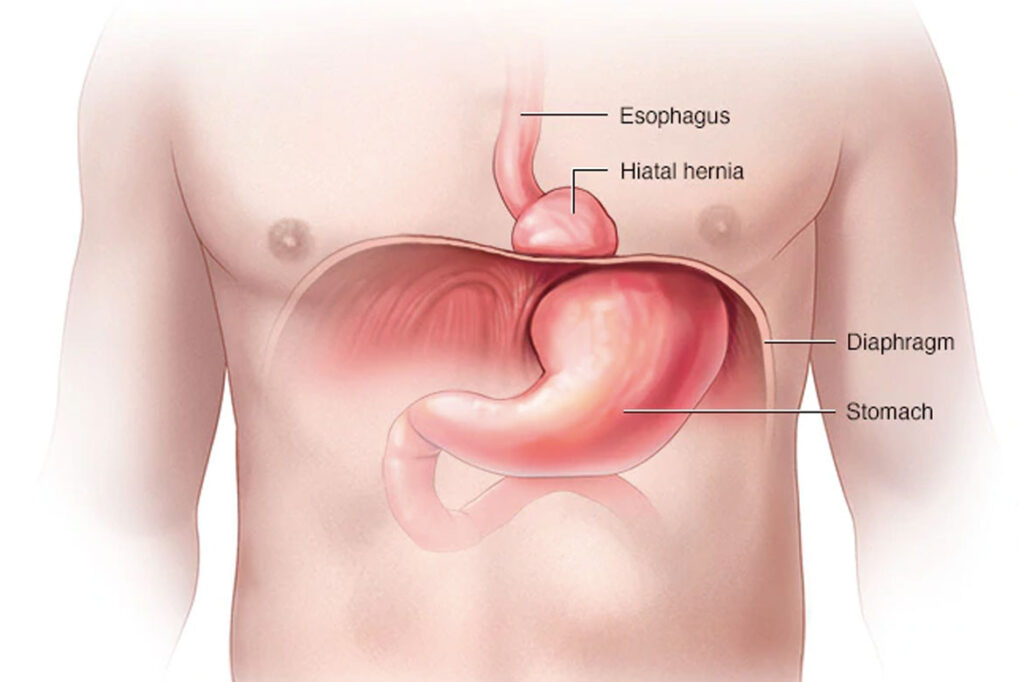A hiatus hernia, also known as a hiatal hernia, occurs when part of the stomach pushes upwards through the hiatus, an opening in the diaphragm through which the oesophagus passes before connecting to the stomach. This anatomical abnormality can lead to various discomforting symptoms and conditions, most notably gastroesophageal reflux disease (GERD). The severity of the symptoms and the nature of the hernia often determine the treatment approach, ranging from simple lifestyle adjustments to more complex surgical interventions. In severe cases, especially where surgical resolution is required, finding the best hernia surgery in Delhi is crucial for achieving optimal outcomes.
Understanding Hiatus Hernia
Hiatus hernias are classified into two main types: sliding and paraesophageal. The sliding type, which is more common, involves the stomach and the lower part of the oesophagus sliding up into the chest through the hiatus. This form is generally less severe and often managed with conservative treatments. In contrast, the paraesophageal hernia, though less common, is considered more serious. In this type, part of the stomach squeezes through the hiatus, sitting alongside the oesophagus without slipping back down. This can lead to more significant complications, including the risk of strangulation (cutting off blood supply to the stomach), which is a medical emergency.
Symptoms of Hiatus Hernia
While small hiatal hernias often go unnoticed, larger hernias can cause noticeable symptoms that may significantly impact daily life. Common symptoms include:
- Heartburn or acid regurgitation, particularly pronounced when bending over or lying down
- Chest pain that may mimic heart-related issues
- Difficulty swallowing, which can affect nutrition and hydration
- Frequent belching and feelings of bloating or abdominal fullness after meals
- Shortness of breath if the hernia is large enough to impinge on lung function
These symptoms generally worsen during activities that increase intra-abdominal pressure, such as eating, strenuous activities, or sleeping without adequate head elevation.
Causes and Risk Factors
The exact cause of hiatus hernias is not definitively known, but several contributing factors have been identified:
- Increased Abdominal Pressure: Obesity, pregnancy, intense coughing, or straining during bowel movements can all increase the pressure within the abdominal cavity, potentially forcing the stomach through the hiatus.
- Age-Related Changes: As people age, the diaphragm can weaken, and the structures that keep the stomach in place may become less effective.
- Injury or Previous Surgery: Trauma to the area or surgical procedures involving the diaphragm can predispose individuals to developing a hiatus hernia.
Diagnostic Procedures
Diagnosing a hiatus hernia typically involves a combination of a physical examination and specialized tests, which may include:
- Barium Swallow X-ray: This test involves swallowing a barium solution that coats the digestive tract, making the outline of the oesophagus and stomach visible on an X-ray.
- Endoscopy: A flexible tube with a light and camera (endoscope) is inserted down the throat to examine the inside of the oesophagus and stomach.
- Esophageal Manometry: This test measures the rhythmic muscle contractions in the esophagus when you swallow and the coordination and force exerted by the esophageal muscles.
Treatment Strategies
Lifestyle Modifications
For patients with mild symptoms, lifestyle changes can be highly effective in managing a hiatus hernia:
- Avoiding large or heavy meals that can increase stomach pressure
- Not lying down or bending over right after eating to prevent reflux
- Losing weight to decrease abdominal pressure
- Elevating the head of the bed to reduce symptoms at night
- Avoiding foods and drinks that trigger reflux, such as caffeine, chocolate, and acidic foods
Medication
Various medications can be used to alleviate symptoms:
- Antacids: Neutralize stomach acid and can provide quick relief.
- H2-receptor blockers and proton pump inhibitors: Decrease acid production in the stomach.
- Prokinetics: Help strengthen the lower oesophagal sphincter, increase the rate of gastric emptying, and reduce reflux symptoms.
Surgical Treatment
In cases where the hernia is large, symptoms are severe, or conservative treatments fail to provide relief, surgery may be necessary. The most common surgical procedure for repairing a hiatus hernia is fundoplication. This involves wrapping the upper part of the stomach around the lower oesophagus to strengthen the sphincter, prevent acid reflux, and repair the hernia.
Conclusion
Hiatus hernias can range from minor health nuisances to significant medical concerns requiring surgery. Managing this condition effectively requires a tailored approach that can include lifestyle modifications, medication, and possibly surgery. For those in Delhi needing surgical intervention, careful selection of a surgeon and healthcare facility is paramount to ensure successful management and swift recovery. Through appropriate treatment, patients can achieve significant relief from symptoms and a marked improvement in their quality of life.



